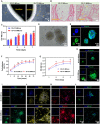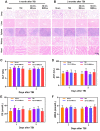Integrated printed BDNF-stimulated HUCMSCs-derived exosomes/collagen/chitosan biological scaffolds with 3D printing technology promoted the remodelling of neural networks after traumatic brain injury
- PMID: 36683754
- PMCID: PMC9847532
- DOI: 10.1093/rb/rbac085
Integrated printed BDNF-stimulated HUCMSCs-derived exosomes/collagen/chitosan biological scaffolds with 3D printing technology promoted the remodelling of neural networks after traumatic brain injury
Abstract
The restoration of nerve dysfunction after traumatic brain injury (TBI) faces huge challenges due to the limited self-regenerative abilities of nerve tissues. In situ inductive recovery can be achieved utilizing biological scaffolds combined with endogenous human umbilical cord mesenchymal stem cells (HUCMSCs)-derived exosomes (MExos). In this study, brain-derived neurotrophic factor-stimulated HUCMSCs-derived exosomes (BMExos) were composited with collagen/chitosan by 3D printing technology. 3D-printed collagen/chitosan/BMExos (3D-CC-BMExos) scaffolds have excellent mechanical properties and biocompatibility. Subsequently, in vivo experiments showed that 3D-CC-BMExos therapy could improve the recovery of neuromotor function and cognitive function in a TBI model in rats. Consistent with the behavioural recovery, the results of histomorphological tests showed that 3D-CC-BMExos therapy could facilitate the remodelling of neural networks, such as improving the regeneration of nerve fibres, synaptic connections and myelin sheaths, in lesions after TBI.
Keywords: BDNF; chitosan; collagen; exosomes; mesenchymal stem cell; traumatic brain injury.
© The Author(s) 2022. Published by Oxford University Press.
Figures









Similar articles
-
Hypoxia-pretreated mesenchymal stem cell-derived exosomes-loaded low-temperature extrusion 3D-printed implants for neural regeneration after traumatic brain injury in canines.Front Bioeng Biotechnol. 2022 Sep 30;10:1025138. doi: 10.3389/fbioe.2022.1025138. eCollection 2022. Front Bioeng Biotechnol. 2022. PMID: 36246376 Free PMC article.
-
3D printing of injury-preconditioned secretome/collagen/heparan sulfate scaffolds for neurological recovery after traumatic brain injury in rats.Stem Cell Res Ther. 2022 Dec 19;13(1):525. doi: 10.1186/s13287-022-03208-0. Stem Cell Res Ther. 2022. PMID: 36536463 Free PMC article.
-
Three-dimensional-printed collagen/chitosan/secretome derived from HUCMSCs scaffolds for efficient neural network reconstruction in canines with traumatic brain injury.Regen Biomater. 2022 Jun 27;9:rbac043. doi: 10.1093/rb/rbac043. eCollection 2022. Regen Biomater. 2022. PMID: 35855109 Free PMC article.
-
Low-temperature 3D-printed collagen/chitosan scaffolds loaded with exosomes derived from neural stem cells pretreated with insulin growth factor-1 enhance neural regeneration after traumatic brain injury.Neural Regen Res. 2023 Sep;18(9):1990-1998. doi: 10.4103/1673-5374.366497. Neural Regen Res. 2023. PMID: 36926724 Free PMC article.
-
3D printing of interferon γ-preconditioned NSC-derived exosomes/collagen/chitosan biological scaffolds for neurological recovery after TBI.Bioact Mater. 2024 May 28;39:375-391. doi: 10.1016/j.bioactmat.2024.05.026. eCollection 2024 Sep. Bioact Mater. 2024. PMID: 38846528 Free PMC article.
Cited by
-
Potential applications of mesenchymal stem cells and their derived exosomes in regenerative medicine.Expert Opin Biol Ther. 2023 Jan-Jun;23(6):491-507. doi: 10.1080/14712598.2023.2211203. Epub 2023 May 9. Expert Opin Biol Ther. 2023. PMID: 37147781 Free PMC article. Review.
-
Serum exosomes miR-206 and miR-549a-3p as potential biomarkers of traumatic brain injury.Sci Rep. 2024 May 2;14(1):10082. doi: 10.1038/s41598-024-60827-8. Sci Rep. 2024. PMID: 38698242 Free PMC article.
-
Current Knowledge and Future Perspectives of Exosomes as Nanocarriers in Diagnosis and Treatment of Diseases.Int J Nanomedicine. 2023 Aug 21;18:4751-4778. doi: 10.2147/IJN.S417422. eCollection 2023. Int J Nanomedicine. 2023. PMID: 37635911 Free PMC article. Review.
-
Application of photocrosslinkable hydrogels based on photolithography 3D bioprinting technology in bone tissue engineering.Regen Biomater. 2023 Apr 24;10:rbad037. doi: 10.1093/rb/rbad037. eCollection 2023. Regen Biomater. 2023. PMID: 37250979 Free PMC article. Review.
-
Adipose-Derived Stem Cell Exosomes Facilitate Diabetic Wound Healing: Mechanisms and Potential Applications.Int J Nanomedicine. 2024 Jun 17;19:6015-6033. doi: 10.2147/IJN.S466034. eCollection 2024. Int J Nanomedicine. 2024. PMID: 38911504 Free PMC article. Review.
References
-
- Qian F, Han Y, Han Z, Zhang D, Zhang L, Zhao G, Li S, Jin G, Yu R, Liu H.. In situ implantable, post-trauma microenvironment-responsive, ROS depletion hydrogels for the treatment of traumatic brain injury. Biomaterials 2021;270:120675. - PubMed
-
- Ma S, Zhou J, Huang T, Zhang Z, Xing Q, Zhou X, Zhang K, Yao M, Cheng T, Wang X, Wen X, Guan F.. Sodium alginate/collagen/stromal cell-derived factor-1 neural scaffold loaded with BMSCs promotes neurological function recovery after traumatic brain injury. Acta Biomater 2021;131:185–97. - PubMed
-
- Li J, Zhang D, Guo S, Zhao C, Wang L, Ma S, Guan F, Yao M.. Dual-enzymatically cross-linked gelatin hydrogel promotes neural differentiation and neurotrophin secretion of bone marrow-derived mesenchymal stem cells for treatment of moderate traumatic brain injury. Int J Biol Macromol 2021;187:200–13. - PubMed
LinkOut - more resources
Full Text Sources

